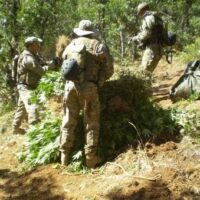 July 28 – About 40 protesters turned up this morning for a press conference and rally to protest the Sacramento Board of Supervisors’ recent move to declare all marijuana cultivation outside of their nine-plant indoor limit a waste of water.
July 28 – About 40 protesters turned up this morning for a press conference and rally to protest the Sacramento Board of Supervisors’ recent move to declare all marijuana cultivation outside of their nine-plant indoor limit a waste of water.
Under an amendment to the county’s state-mandated water conservation ordinance, Supervisor Roberta MacGlashan introduced a “friendly” amendment at the July 14 meeting to include those breaking the county’s outdoor ban and restrictive indoor limits as water wasters, subjecting them to fines of up to $500 a day in addition to the same fines under the marijuana codes, plus a misdemeanor charge.
All the Supervisors assented, and the item was set for final approval on today’s consent agenda, but it was pulled after activists met with Supervisors before the meeting, and several showed up to speak on the item, along with press representatives.
Before anyone could speak, presiding Supervisor Serna offered an amendment, seemingly to answer objections that marijuana growers were singled out for double fines under the proposal. He instead amended it to read that anyone breaking any county code could be fined for wasting water under the new ordinance.
Ellen Komp from California NORML objected to the move, pointing out that surely many of the offenses in County Code have nothing to do with water, and that the measure was obviously nonetheless meant to target marijuana growers.
Many of the speakers questioned MacGlashen’s statement that marijuana uses six gallons of water per plant, a figure that’s been parroted by many after Fish and Wildlife officials lifted it from a 2010 Humboldt Growers Association document outlining a worst-case scenario for large plants of the kind that prevail when plant-based limits, rather than square footage allotments, are imposed. Sac NORML board member Richard Miller interviewed several local growers and came up with figures of half that much per plant, and also made calculations in line with Emerald Growers Association’s figure of one gallon of water per gram of cannabis produced. Miller compared that amount with the 15 gallons of water required to produced a glass of wine.
Komp pointed out that the 1000-plant garden in MacGlashen’s district that lead to the amendment was not using the municipal water that the Board oversees, but rather was drawing from a creek, and cited under a Fish & Game violation for doing so. Over 100 roosters being raised for cock fighting were also found at that location, and Ron Mullins of Sacramento NORML noted that there was no move to take water away from chickens in the county because of a single bad actor.
It was pointed out that the county’s intransigence in regulating outdoor and collective grows is running counter to state efforts to regulate such grows. At a July 17 meeting at the Central Valley Water Board in Redding, a draft pilot program for regulating water use and discharge for marijuana gardens was unveiled, with officials from the Water Board and Fish & Wildlife hoping to finalize the program in October. At that meeting, it was noted that farmers in counties with cultivation bans would be unable to participate in regulation, though they could be enforced upon for breaking environmental laws.
Many medical marijuana patients spoke about their need to grow the plant, and pointed out that many other crops use more water. Other activists suggested “friendly” amendments to ban fracking (which uses an estimated 80 billion gallons of water yearly in California) and bottling of water by Nestlé (which has a contract to bottle millions of gallons at the user rate in the city of Sacramento).
Nonetheless, all five supervisors voted for Cerna’s amendment, and county counsel advised that a second vote would need to be taken on the revision at their next meeting on August 11.
Activists then took to the streets, donning orange T-shirts printed with a fable about Supervisor MacGlashen’s lack of compassion (hey, that rhymes!) based on The Lorax. The group marched many blocks in the near-100-degree heat to the “Fishy Wildlife” building, hoping to confront officials about their questionable six-gallon-per-plant calculation, and also about the dubious practices reported in the Sacramento News & Review. Chanting “Water for healing /Is not stealing” demonstrators surprised and intrigued lunch-goers on Sacramento’s streets.
Also at the meeting, the county sheriff was given approval to apply for a $1.3 million HIDTA grant (High Intensity Drug Trafficking Area) from the federal government, but not before Supervisors Notelli and Cerna agreed to hold hearings on the topic in the fall, with Notelli wondering whether techniques like drug education and treatment might be more effective than interdiction, and Cerna wanting to know what would be spent on methamphetamine and opiates, versus marijuana.
Ironically, the meeting began with the news that a drowning had occurred at the confluence of the Sacramento and American rivers, with Supervisors and other officials discussing prevention measures they were taking such as sineage and enforcing a law requiring children to wear life vests. The idea of bringing in lifeguards was brought up by Supervisor Notelli, with the acknowledgement that there wasn’t funding for such a thing. Supervisor Peters said that perhaps the Board should consider closing the beach, even as weather reports predicted 104 degrees that afternoon.
Thus it seems so far that the Sacramento Board of Supervisors would rather move to punish everyone than offer a little relief to some. And instead of regulating and taxing medical marijuana gardens and collectives, they’d rather spend their scant resources enforcing their increasingly onerous rules against them.
Also see: Sacramento County supervisors retain water-waste fines on pot growth



